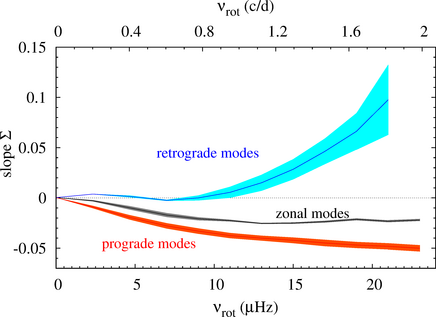Internal rotation of γ Doradus stars
The internal rotation of stars is a fundamental quantity in stellar physics, similar to their mass or metallicity. In a new paper presently on arXiv SAC's Rhita-Maria Ouazzani et al. present a method of determining this parameter for γ Doradus stars

In particular, rotation can strongly affect the stellar structure and its evolution along time. For example, rotation transports chemical elements and angular momentum inside stars. This transport mechanism is crucial because the evolution of a star is dictated by the chemical composition of its central region (through nuclear reactions).
The stellar matter being opaque, the only means to obtain information on the interior of stars is to study their seismology.
Asteroseismology is currently at a key moment of its history. The seismic observations by CoRoT and Kepler have allowed us to prove the standard model wrong. This moment has been called the spatial photometry revolution.

The y axis is an observable of the seismic spectrum, and the x-axis gives the corresponding internal rotation frequency. This is a one-to-one relation that is valid for all the γ Doradus stars, showing how powerful the new diagnostics is.
For now, we are able to follow the evolution of the internal rotation of stars, but only in low mass stars, and in advanced ages (when the stars become red giants). The article presents a method that allows to perform such a measurement for a subset of the red giants stars progenitors: the γ Doradus stars. Because these stars exhibit seismic modes that probe their innermost regions, the g-modes, we are now able to determine the internal rotation of low mass stars in the evolution stage where their burn hydrogen in their core (called the main sequence), which is still not possible for Sun-like stars.
The paper can be found here.
